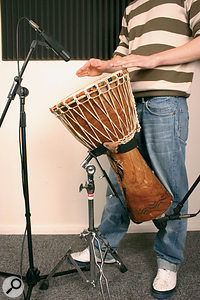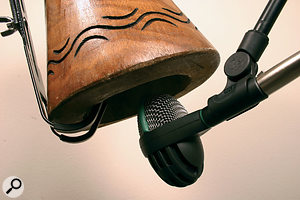The crack team of Paul White and Hugh Robjohns have traveled the world solving readers' problems. Here, they down the Hob
Nobs and answer some of your recording queries in our Q and A
mini-series, Sound Advice.



Hugh: The djembe is a type of African drum, shaped like a goblet, and made from a single piece of wood. Its head, traditionally goatskin, is stretched over the top and tensioned with string. Like the conga, the djembe is played by hand, and has an opening at the bottom of its hollow, tubular shell which acts as a Helmholtz Resonator. Most of the tone and volume of the bass resonance emerges from the bottom of the tube when the drum is struck in the centre of the skin, while the higher-pitched percussive sounds come from the drum skin when played closer to the edge.
Paul: Because of that large bass tube, the djembe needs to be lifted off the floor to to allow sound to escape from the bottom of the drum. For recording, many players use a metal floor stand or cradle, rather than holding it between their knees, as it keeps the drum still. The pictures, right, show a traditionally made djembe in such a stand.
Hugh: When it comes to miking the drum, I'll always listen carefully to the sound that the drum is making in the room. Only then will I make an informed decision on where to place the mics.
If you have a nice-sounding room, and can afford to mic the drum from a distance, then a single (mono or stereo) mic, positioned in a place where there's optimum balance between bass and percussive sounds, should give good results. However, in any kind of performance situation where there are other instruments playing in the vicinity, or where you specifically want a closer, more intimate sound, or where the room has no worthwhile sound character, you are almost certainly going to have to use two close mics. This is because the traditional approach of a single mic above the drum head simply won't capture the bass energy in the right proportion.
Paul: When tackling the top of the drum, I'd usually start around 12 inches from the drum skin, using a small-diaphragm, cardioid capacitor microphone. If you don't have one of these, a good dynamic will yield good results, but you'll have to get closer to the drum head, maybe within four to six inches.
Hugh: Whatever you use and wherever you place it, try to aim it roughly halfway between the edge and the centre to capture the percussive sound of the hand hitting the head. You can experiment with the exact angle and aiming point of the mic to change and control the tone slightly. The second mic is used to capture the weight and tone of the bass resonance from below, and would usually be placed somewhere close to (or maybe even an inch or two inside) the mouth of the base, as shown in the pictures. Alternatively, you could place a pressure zone (boundary layer) mic on the floor below the mouth of the djembe, or use an omnidirectional mic on a thin sheet of foam directly on the floor. This approach gives a more natural bass sound, to my ears, and is well worth a try if you have suitable mics. Just beware of foot-tapping or other floor vibrations. Of course, experimentation is the key, because the best djembes are hand-made, and every one will be different.
Paul: As is regularly mentioned in the hallowed pages of SOS, if the room is adding unpleasant tonality to the sound of the drum, hanging the ubiquitous duvet around and to the sides of the drum will help damp down the sound. It is possible to over-dampen, so try sticking a tea tray under the drum if you think it's a little dull.
Hugh: Mic selection is much the same as for any percussion or drum kit, hence the use of the AKG D112 inside the base. (Alternatives include Shure's Beta 52, the EV RE20, or Sennheiser's E902 — basically anything suitable for miking bass drums). When miking the skin, good-quality dynamic mics such as the venerable Shure SM57 or Sennheiser MD421 will tend to give a slightly fatter, more flattering sound. A condenser mic such as a Rode NT5 or AKG C451, by contrast, will tend to give more detail and percussive edge, but watch out for overloads if you're close-miking. A mic with a 10dB pad is often a good idea.
Paul: Once you've got your djembe recorded, you may find that the levels vary too much on playback, as the instrument is very dynamic. Compression will help, and using an attack time of around 10ms will allow the drum hits to come through cleanly, while taking around four to five decibels off the very loudest peaks should help to even them out. You may have to be more severe on recordings with excessive dynamic range.
Published August 2007
No comments:
Post a Comment